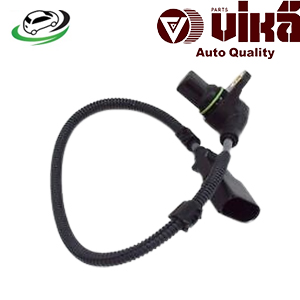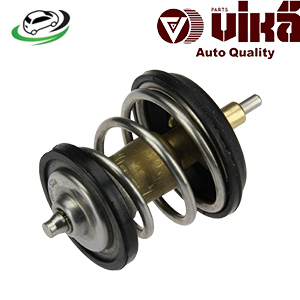-10%
Get AUDI 8U Q3/ A3 8P/ B8 A4/ B8 A5/ C7 A6/ Q5/ TT MKII / VW CC/ EOS/ Golf V/VI/ Passat B6/ Tiguan 1/2/ Jetta V Thermostat 06H121113B
An automotive thermostat is a valve that controls the flow of coolant between the engine and the radiator. It is designed to maintain the engine at its optimal operating temperature by regulating when coolant is allowed to pass through the engine’s cooling system.
The thermostat remains closed when the engine is cold, preventing coolant from flowing to the radiator. This allows the engine to warm up quickly. Once the engine reaches a specific temperature, the thermostat opens, allowing coolant to circulate and cool the engine.
Primary Function of the Thermostat
- Regulating Engine Temperature: The thermostat ensures that the engine heats up quickly to its optimal operating temperature (typically around 195°F to 220°F or 90°C to 105°C) and prevents overheating by allowing coolant to flow through the radiator when necessary.
- Fuel Efficiency: By allowing the engine to reach its optimal temperature more quickly, the thermostat helps improve fuel efficiency. Cold engines burn more fuel, so reaching operating temperature efficiently is essential for reducing fuel consumption.
- Engine Protection: Maintaining the proper engine temperature protects critical engine components from thermal stress and damage, ensuring a longer engine lifespan.
2. Components of an Automotive Thermostat
The thermostat is a relatively simple mechanical device but is made up of several key components:
1. Thermostat Housing:
The thermostat is housed in a protective casing made of metal or plastic. The housing connects the thermostat to the engine block and the radiator.
2. Main Valve:
This is the actual part of the thermostat that opens and closes to regulate coolant flow. The valve is temperature-sensitive, designed to open at a specific engine temperature.
3. Wax Pellet:
A wax pellet is located inside the thermostat and acts as the temperature-sensitive element. When the engine heats up, the wax expands, pushing the valve open and allowing coolant to flow.
4. Spring:
The spring helps to close the valve when the engine cools down, ensuring that coolant flow is halted when not needed.
5. Seal:
A rubber or silicone gasket surrounds the thermostat to prevent leaks and ensure a proper seal between the thermostat and the engine block or housing.
3. How the Thermostat Works
The operation of an automotive thermostat is based on simple thermal expansion and contraction principles. Here’s a step-by-step look at how it works:
1. Engine Cold (Thermostat Closed):
When the engine is cold (such as during startup), the thermostat remains closed. This prevents coolant from flowing through the radiator, allowing the engine to warm up quickly. The thermostat traps the coolant within the engine block, maintaining a higher temperature around the engine’s cylinders.
2. Engine Warms Up:
As the engine runs, it generates heat, causing the temperature of the coolant within the engine to rise. The heat is transferred to the wax pellet inside the thermostat. When the coolant reaches the thermostat’s designated temperature (usually around 195°F or 90°C), the wax inside the thermostat expands and begins to melt.
3. Thermostat Opens:
As the wax expands, it pushes a piston that compresses the spring and opens the valve. This allows coolant to flow from the engine to the radiator, where it is cooled by the air passing through the radiator fins.
4. Thermostat Adjusts Coolant Flow:
The thermostat doesn’t simply snap open or closed. As the coolant temperature fluctuates, the thermostat continuously adjusts its position, allowing more or less coolant to flow through the radiator as needed to maintain the optimal engine temperature.
5. Engine Cools Down (Thermostat Closes):
Once the engine cools down and the coolant temperature drops below the thermostat’s threshold, the wax contracts, and the spring forces the valve closed again. This stops the flow of coolant, allowing the engine to warm back up to its optimal temperature.
4. Types of Thermostats
There are several different types of thermostats used in automotive engines, each with unique characteristics and applications:
1. Wax-Pellet Thermostats:
This is the most common type of thermostat in modern vehicles. It uses a wax pellet that expands and contracts based on temperature changes, as explained above.
2. Bypass Thermostats:
These thermostats are designed to allow a small amount of coolant to circulate even when the thermostat is closed. This helps reduce thermal shock and ensures smoother temperature transitions when the thermostat opens.
3. Electronically Controlled Thermostats:
Some modern vehicles use thermostats that are electronically controlled by the vehicle’s engine control unit (ECU). These thermostats can open and close based on real-time engine data, allowing for more precise temperature regulation and improved fuel efficiency.
4. Dual Thermostats:
Some engines, particularly those with complex cooling systems (e.g., turbocharged or high-performance engines), use dual thermostats. One thermostat controls the coolant flow in the engine block, while the other controls flow to the cylinder head. This design ensures more efficient cooling for high-performance applications.
5. Benefits of a Properly Functioning Thermostat
The thermostat is crucial for engine performance and longevity. Some of the key benefits include:
1. Optimal Engine Performance:
The thermostat ensures the engine operates at the correct temperature, which is essential for efficient combustion, optimal fuel consumption, and smooth engine operation.
2. Improved Fuel Efficiency:
By allowing the engine to reach its ideal operating temperature quickly, the thermostat helps improve fuel economy. Engines that run too cold burn more fuel.
3. Protection from Overheating:
A functioning thermostat prevents the engine from overheating by allowing the coolant to flow through the radiator when necessary. Overheating can cause severe engine damage, including warped cylinder heads, blown head gaskets, and cracked engine blocks.
4. Reduced Emissions:
An engine that operates at the correct temperature burns fuel more efficiently, which in turn reduces harmful emissions. A cold engine produces more pollutants due to incomplete combustion.
5. Extended Engine Lifespan:
By maintaining proper engine temperature, the thermostat reduces wear and tear on engine components, extending the lifespan of the engine.
6. Common Issues with Thermostats
Like any mechanical component, thermostats can develop problems over time. Some of the most common thermostat issues include:
1. Stuck Open Thermostat:
If the thermostat is stuck in the open position, coolant will continuously flow through the engine, preventing it from reaching its optimal operating temperature. This can result in poor fuel efficiency, increased emissions, and reduced engine performance.
2. Stuck Closed Thermostat:
A stuck closed thermostat prevents coolant from flowing to the radiator, leading to engine overheating. Overheating can cause serious engine damage and should be addressed immediately.
3. Leaking Thermostat Housing:
A damaged or improperly installed thermostat housing can cause coolant leaks, leading to low coolant levels and engine overheating.
4. Erratic Temperature Readings:
A faulty thermostat may cause erratic temperature readings, where the engine temperature fluctuates unpredictably. This can lead to poor engine performance and potential overheating.
7. Thermostat Maintenance and Replacement
Although thermostats are generally low-maintenance components, they can wear out over time and require replacement. Here are some key maintenance tips and information on thermostat replacement:
Signs of a Failing Thermostat:
- The engine takes a long time to warm up, or it never reaches the optimal operating temperature.
- The engine overheats frequently or runs too cold.
- Erratic temperature gauge readings.
- The check engine light is triggered, especially if the ECU detects temperature irregularities.
Replacing a Thermostat:
Replacing a thermostat is a relatively straightforward procedure but should be done by a professional mechanic. The process typically involves:
- Draining the coolant.
- Removing the thermostat housing.
- Replacing the old thermostat with a new one.
- Reinstalling the thermostat housing and refilling the coolant.
The cost of a thermostat replacement can vary depending on the vehicle make and model, but it is generally an affordable repair.
8. Conclusion
The thermostat is a small but essential component in the automotive cooling system, responsible for maintaining the engine’s optimal temperature. By regulating the flow of coolant, the thermostat ensures that the engine warms up quickly, operates efficiently, and avoids overheating. A properly functioning thermostat is critical for optimal engine performance, fuel efficiency, and long-term engine health. Regular maintenance and timely replacement of faulty thermostats are essential for keeping the engine running smoothly and preventing costly repairs.
Follow us on Facebook for more parts.




Reviews
Clear filtersThere are no reviews yet.